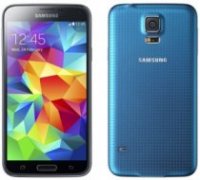Samsung Galaxy S5 review VS iPhone 5s

Introduction
Samsung's 2014 flagship, the Galaxy S5, broke away from its predecessors' heritage with a water-resistance certification, and a new “perforated” rear cover design. That's not all, though, as Samsung also went after the Touch ID fingerprint sensor in the iPhone 5s, providing a scanner of its own in the home key, and added a unique heartrate sensor on the back, to make its flagship stand out.As usual, we are staging a UFC combat between the “perforated” looks and the new features of the 5.1” Galaxy S5, against the slender steel-and-glass frame of the iPhone 5s, as this has become the heavyweights fight in the Android vs iOS championship. Which one has done the fingerprint sensing right? Whose camera takes better pictures? How are the interfaces different? Which one will leave the fight more bruised and battered ? Let's find out...
Plastic-fantastic S5 feels less premium to hold, but its water-resistant design still lets you swap the battery or add more memory. Its fingerprints sensor is more cumbersome to use than Touch ID, though.
Measuring at just 8.1 mm, the Galaxy S5 is thicker than the 4” iPhone 5s, and much larger, heavier, and cumbersome to use with one hand, as it houses a 5.1" display. Its plastic build introduces a new ”perforated” back refrain, which comes in four colors, including a golden version. Apple's handset also has a gold-colored variant, but the iPhone is crafted in a very different way, with premium metal and glass materials for the chassis. If you don't mind the polycarbonate casing of the S5, however, it will offer you not only a bigger screen, but also an IP67 certification, letting you dunk it in three feet (1 meter) of water for up to half an hour. You can still remove the back cover, in the best of Samsung's traditions, which gives you easy access to swap the battery, or add memory with a microSD card – possibilities that the iPhone 5s doesn't offer.Apple shook the mobile phone industry with a unique Touch ID sensor embedded in the home key, which is the first fingerprint sensor on a mobile device done right. Samsung was apparently in a jiffy to catch up, and integrated a swipe Finger Scanner in the S5's home key in its turn. Queue the copycat jokes here, but the two sensors work in quite a different manner. Not only do the iPhone's dimensions make Touch ID way easier to use with one hand, but it is also much more sensitive than what Samsung offers.
Upon initial setup, Apple's creation takes a “snapshot” of your fingerprint in all possible positions, so you can unlock the phone with the slightest touch, no matter how crooked your digit lands. The fingerprint scanner on the S5 stays true to its title, requiring you to swipe directly over the home key for it to work, which means that you usually have to hold the phone with the other hand. Imagine having to put down your bags of groceries each time you need to check something on your phone – you'll quickly prefer to ditch the print sensing altogether.If you register your thumb swiping it diagonally over the home key in the first place, however - the way you would use it when holding the phone with one hand - the S5 will record this position, and you will be able to unlock the phone easily by swiping briefly almost in parallel to the home key. It worked most of the time with us, as you can see in the video below.
Another unique new feature of the S5 is the heartrate sensor on the back, next to the LED flash. It is tightly integrated with Samsung's S Health app, and requires you to press your finger against it for a few seconds, before it takes an optical pulse reading. Some might dismiss this as a gimmick for the sake of inserting something new, but for athletes or older users it might present a convenient way to check their pulse without manually calculating beat counts.
FIT
5.59 x 2.85 x 0.32 inches
142 x 72.5 x 8.1 mm
5.11 oz (145 g)
4.87 x 2.31 x 0.3 inches
123.8 x 58.6 x 7.6 mm
3.95 oz (112 g)
The phones sport bright displays, with good viewing angles, and nice outdoor visibility, but the default Standard mode on the S5 display exhibits way too saturated colors, and cold overall appearance.
The S5 has a 5.1" Full HD Super AMOLED screen with 432ppi pixel density, while the 4" 640x1136 pixels IPS-LCD display on the iPhone has 326ppi. You won't be able to notice the individual pixels on both displays from a normal viewing distance, but if you examine the screens closely, the S5 panel would come out sharper.Apple has proven many times that its phone display panels flaunt almost perfect sRGB gamut color representation, whereas the AMOLED panels exhibit somewhat saturated, even gaudy colors. The same goes here, with the latest S5 and the iPhone 5s. By default, the color temperature of the Galaxy S5 screen is 8000K, resulting in very blueish, cold image. The Professional profile makes things better, with temperature of 7270K, almost on par with iPhone's 7150K. However, the S5 screen still has that cold feel, as its screen emphasizes green and blue. Here we should note that although the AMOLED screens of Samsung flagships are not very color-accurate, most people like them for that “wow” factor of their oversaturated imagery. The Galaxy S5 has deeper black levels, and lower minimum brightness (2 nits), too, which makes it a tad gentler on your eyes in very dark environments.
Source: www.phonearena.com






